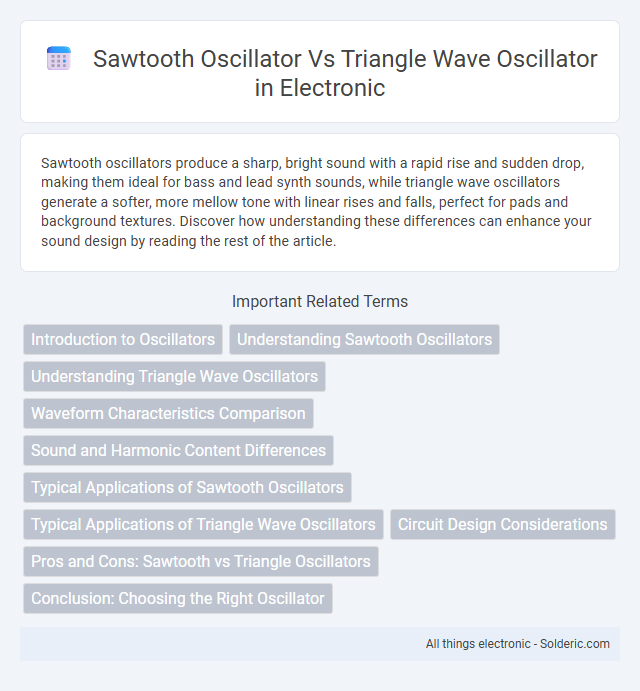Sawtooth oscillators produce a sharp, bright sound with a rapid rise and sudden drop, making them ideal for bass and lead synth sounds, while triangle wave oscillators generate a softer, more mellow tone with linear rises and falls, perfect for pads and background textures. Discover how understanding these differences can enhance your sound design by reading the rest of the article.
Comparison Table
| Feature | Sawtooth Oscillator | Triangle Wave Oscillator |
|---|---|---|
| Waveform Shape | Linear rising edge, rapid falling edge | Symmetrical linear rise and fall |
| Sound Character | Bright, rich in harmonics | Smoother, softer tone |
| Harmonic Content | Contains both even and odd harmonics | Only odd harmonics, lower amplitude |
| Application | Used in synthesizers, electronic music | Common in modulation, sound synthesis |
| Generation Method | Charging capacitor with constant current, rapid discharge | Integrating a square wave signal |
| Frequency Stability | Moderate, sensitive to component variation | High, better frequency accuracy |
| Complexity | Simple circuit design | Requires integrator circuit |
Introduction to Oscillators
Sawtooth oscillators produce a waveform with a sharp rise and gradual fall, generating rich harmonic content ideal for synthesizers and audio applications requiring bright, buzzy tones. Triangle wave oscillators create smoother waveforms with linear slopes, resulting in fewer harmonics and a softer, more mellow sound commonly used in bass and lead instruments. Your choice between sawtooth and triangle oscillators depends on the desired timbre and harmonic complexity in electronic sound design.
Understanding Sawtooth Oscillators
Sawtooth oscillators produce waveforms with a linear rise and a sharp fall, creating rich harmonic content ideal for complex sound synthesis. Unlike triangle wave oscillators, which generate smoother and softer tones with only odd harmonics, sawtooth oscillators offer a full spectrum of harmonics that enhance sound brightness. Understanding sawtooth oscillators helps you tailor your audio designs by leveraging their distinctive, sharp-edged timbre for more dynamic and versatile sound shaping.
Understanding Triangle Wave Oscillators
Triangle wave oscillators generate a waveform characterized by linear rising and falling slopes, producing a smooth, symmetrical shape ideal for audio synthesis and modulation. Unlike sawtooth oscillators, which have sharp, asymmetric edges and richer harmonic content, triangle wave oscillators emphasize a softer sound with primarily odd harmonics. Your choice between these oscillators depends on the desired tonal quality and harmonic complexity in your electronic music or signal processing projects.
Waveform Characteristics Comparison
Sawtooth oscillators produce a waveform with a sharp linear rise followed by an abrupt drop, creating a distinctive bright and buzzy sound, while triangle wave oscillators generate a smooth, linear rise and fall with rounded peaks, resulting in a softer, more mellow tone. The sawtooth wave contains all integer harmonics, giving it a rich harmonic spectrum, whereas the triangle wave includes only odd harmonics with rapidly decreasing amplitudes, leading to a purer sound. Understanding these waveform characteristics helps you choose the right oscillator for your desired audio texture and synthesis application.
Sound and Harmonic Content Differences
Sawtooth oscillators produce a bright, buzzy sound rich in both even and odd harmonics, creating a full spectrum of harmonic content ideal for emulating brass and string instruments. Triangle wave oscillators generate a softer, smoother tone with predominantly odd harmonics and rapidly diminishing higher frequencies, resulting in a mellow, flute-like quality. The distinct harmonic structures make sawtooth waves ideal for aggressive, cutting sounds, while triangle waves excel in warm, gentle timbres.
Typical Applications of Sawtooth Oscillators
Sawtooth oscillators are widely used in music synthesis and sound design due to their rich harmonic content and bright timbre, making them ideal for creating brass, string, and electronic sounds. They find applications in television and video systems for generating horizontal and vertical sync signals because of their linear ramp waveform, which is crucial for image scanning. Furthermore, sawtooth oscillators serve in analog synthesizers and waveform modulation circuits where precise frequency control and complex waveform generation are needed.
Typical Applications of Triangle Wave Oscillators
Triangle wave oscillators are commonly used in applications requiring linear frequency modulation, such as audio synthesis and signal processing. Their smooth, linear ramp makes them ideal for testing and calibration of amplifiers and filters. You will find triangle waves also useful in function generators where precise and stable waveforms are essential.
Circuit Design Considerations
Sawtooth oscillators require precise timing circuits with rapid charging and slow discharging paths to produce the characteristic linear ramp and sharp drop, making component tolerances critical for waveform stability. Triangle wave oscillators rely on integrator circuits with matched dual-slope ramps, demanding accurate operational amplifier configurations and low leakage capacitors for symmetry and minimal distortion. Your choice between sawtooth and triangle oscillators hinges on circuit complexity, linearity requirements, and achievable component precision.
Pros and Cons: Sawtooth vs Triangle Oscillators
Sawtooth oscillators generate rich harmonic content with both even and odd harmonics, making them ideal for bright, buzzy sounds but introducing more aliasing and CPU load. Triangle oscillators produce smoother, softer tones with primarily odd harmonics, offering a more filtered, mellow sound and lower aliasing, but lack the brightness and complexity of sawtooth waves. When choosing between them, consider your sound design goals and processing constraints to optimize Your synthesis.
Conclusion: Choosing the Right Oscillator
Choosing the right oscillator depends on the desired sound characteristics and application context; sawtooth oscillators generate rich, harmonically complex tones ideal for basses and leads, while triangle wave oscillators produce smoother, softer sounds suitable for pads and mellow textures. Both oscillators offer unique spectral qualities, with sawtooth waves containing all harmonics and triangle waves emphasizing odd harmonics with rapid attenuation. Understanding these differences allows producers and engineers to select the optimal waveform for synthesis tasks, enhancing tonal precision and creative expression.
sawtooth oscillator vs triangle wave oscillator Infographic

 solderic.com
solderic.com